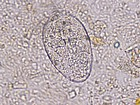Difference between revisions of "Paramphistomum"
Jump to navigation
Jump to search
| (17 intermediate revisions by 3 users not shown) | |||
| Line 1: | Line 1: | ||
| − | + | ||
| − | + | == ''Paramphistomum'' Species == | |
| − | |||
| − | |||
| − | |||
| − | |||
| − | |||
| − | |||
| − | |||
| − | |||
| − | |||
| − | |||
| − | |||
| − | |||
| − | |||
[[Image:Paramphistomum cervi.jpg|right|150px|thumb|''Paramphistomum cervi'' - Joaquim Castellà Veterinary Parasitology Universitat Autònoma de Barcelona]] | [[Image:Paramphistomum cervi.jpg|right|150px|thumb|''Paramphistomum cervi'' - Joaquim Castellà Veterinary Parasitology Universitat Autònoma de Barcelona]] | ||
| − | + | *Paramphistomomes are rare in the UK, but can cause severe losses in ruminants in the wet tropics | |
| − | + | *The adult fluke is plump and cylindrical (unusual for a trematode) | |
| − | The adult fluke is plump and cylindrical (unusual for a | + | *It attaches to the wall of the rumen without causing serious damage |
| − | + | *The eggs are like those of ''Fasciola'', but are colourless | |
| − | The intermediate hosts are water snails | + | *The intermediate hosts are water snails |
| − | + | **These shed cercariae that form metacercariae on vegetation | |
| − | Disease occurs if metacercariae are eaten in large numbers | + | *Disease occurs if metacercariae are eaten in large numbers |
| − | + | *Enteritis and diarrhoea result when immature flukes migrate along the small intestine (where the metacercariae excyst) towards the rumen | |
| − | |||
| − | |||
| − | |||
| − | |||
| − | |||
| − | |||
| − | |||
| − | |||
| − | |||
| − | |||
| − | |||
| − | |||
[[Category:Trematodes]] | [[Category:Trematodes]] | ||
| − | |||
Revision as of 22:17, 28 April 2010
Paramphistomum Species
- Paramphistomomes are rare in the UK, but can cause severe losses in ruminants in the wet tropics
- The adult fluke is plump and cylindrical (unusual for a trematode)
- It attaches to the wall of the rumen without causing serious damage
- The eggs are like those of Fasciola, but are colourless
- The intermediate hosts are water snails
- These shed cercariae that form metacercariae on vegetation
- Disease occurs if metacercariae are eaten in large numbers
- Enteritis and diarrhoea result when immature flukes migrate along the small intestine (where the metacercariae excyst) towards the rumen
